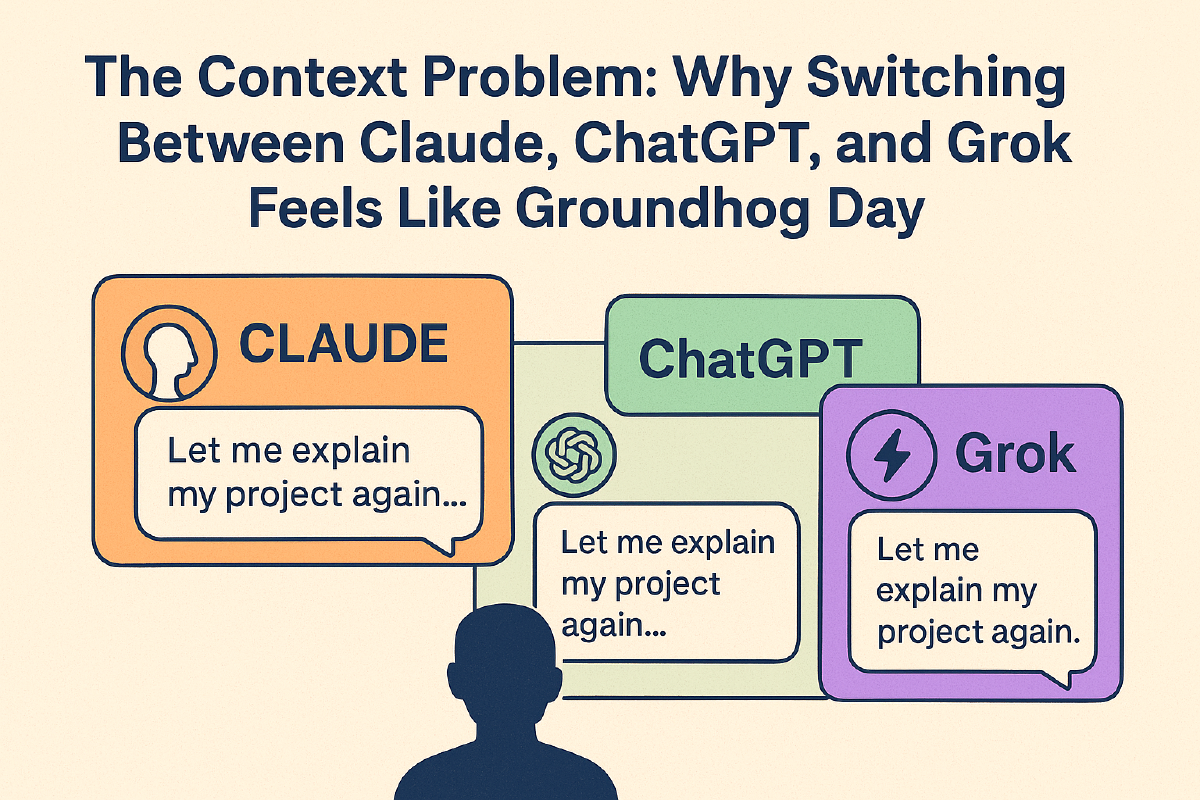You just spent 20 minutes teaching Claude your codebase. The mental model is perfect. Claude gets the architecture, knows your constraints, understands the goal.
Then you remember ChatGPT is better at Python refactoring. You switch over.
“Let me explain my project again…”
Stop. Before you paste that context for the hundredth time, let’s talk about what’s really happening here. Not the surface-level “AIs don’t share memory” explanation. The real engineering. The deliberate decisions. The philosophy of what context even means.
Because once you understand how AI memory actually works, you’ll see why this problem exists, and why it might never be “solved” the way you think.
The 10-minute mental model#
Let’s build your understanding from first principles. Here’s what “context” actually means in AI systems:
1. Context is attention, literally#
When you talk to an AI, your words become tokens (numerical representations). These tokens flow through attention mechanisms that decide what’s relevant. Context isn’t “stored” like files on disk. It’s a temporary computational state, like RAM, not a hard drive.
Every token costs compute. A 200K context window means the model is actively attending to 200,000 tokens worth of patterns every single time it generates a response. That’s why context is expensive. It’s not storage cost, it’s processing cost.
2. Memory is retrieval, not recording#
When ChatGPT “remembers” you prefer React, it’s not writing to a database. It’s creating embeddings (mathematical fingerprints of concepts) and storing those in a vector space. Next conversation, it searches that space for relevant patterns and injects them into the context.
Think of it like this: The AI doesn’t remember conversations. It remembers the shape of conversations and reconstructs relevant bits on demand.
3. Sessions are stateless by design#
Here’s the kicker: Large language models are fundamentally stateless. They’re functions: text in, text out. No persistence. Every “memory” feature is scaffolding built around this stateless core.
Why? Because stateless is scalable. One model can serve millions of users simultaneously. Add state, and suddenly you need persistent storage, session management, consistency guarantees. The infrastructure complexity explodes.
Why context doesn’t transfer (and never will)#
Here’s where it gets interesting. The context problem isn’t technical. It’s architectural, economic, and philosophical:
The embedding incompatibility problem#
Each AI uses different embedding models. Claude’s vector representation of “Python” differs from ChatGPT’s differs from Grok’s. Even if they shared raw text, the semantic understanding wouldn’t translate. It’s like trying to share thoughts between brains with different neural structures.
The context window economics#
A 200K context window at current prices costs about $2-4 per conversation in compute. Multiply by millions of users. Now imagine maintaining that context across sessions, across platforms. The economics don’t work unless someone’s paying (either users directly or through lock-in).
The competitive moat reality#
Let’s be honest: If Claude context seamlessly transferred to ChatGPT, why would you pay for both? Context lock-in is the subscription retention strategy. Every AI provider knows this. Interoperability is antithetical to their business model.
The philosophical divide#
Here’s the deep question: What even is context? Is it the raw text? The extracted meanings? The interaction patterns? Each AI platform has a different answer, and those answers are incompatible by design. They’re not just building different features. They’re building different theories of mind.
How the big three actually implement memory#
Now that you understand the primitives, let’s see how each platform builds “memory” on top of stateless models:
Claude: Structured context hierarchies#
Anthropic took the “explicit is better than implicit” approach:
Projects as context containers. A Project isn’t just a folder. It’s a persistent context namespace. Documents get chunked, embedded, and indexed. When you chat, Claude runs semantic search across project contents and injects relevant chunks into the prompt. It’s RAG (Retrieval Augmented Generation) with a nice UI.
Artifacts as working memory. These aren’t just displayed code. They’re part of the active context. Claude maintains a pointer to artifact state and includes it in subsequent prompts. Close the browser, lose the pointer.
Constitutional memory. Claude uses constitutional AI principles even for memory. It won’t remember things it shouldn’t (passwords, PII) even if you ask. The memory system has built-in ethical constraints.
The philosophy: Claude treats context like a research assistant would. Organized, hierarchical, and bounded. It’s memory as a filing system, not a stream of consciousness.
ChatGPT: Implicit extraction and injection#
OpenAI went for “it just works”:
Automatic memory extraction. After each conversation, ChatGPT runs a secondary pass to extract “memorable” facts. These get stored as embeddings with metadata (timestamp, confidence, topic). No user action required.
Probabilistic injection. New conversations trigger similarity searches across your memory bank. High-scoring memories get prepended to your prompt invisibly. You never see this happening. It’s seamless.
Cross-session state. ChatGPT maintains a persistent user profile that evolves. It’s not just remembering facts; it’s building a model of you. Your writing style, reasoning patterns, preferences. All get encoded.
The philosophy: Memory should be invisible and automatic. The AI adapts to you, not the other way around. It’s memory as personality modeling.
Grok: Stream processing and real-time context#
xAI took the “everything is a stream” approach:
Event-sourced memory. Grok treats conversations as event streams. Each message is an event that updates the state. Memory is the accumulated state changes over time, allowing for precise replay and branching.
Real-time context injection. The X integration isn’t just API calls. It’s streaming context. Grok maintains a sliding window of relevant real-time data that gets mixed with conversational context. It’s the only one doing true stream processing.
Pattern learning over storage. Grok emphasizes learning interaction patterns over storing facts. It’s less “remembers you like Python” and more “adapts to your communication style.”
The philosophy: Context is fluid and temporal. What matters isn’t what was said, but how it relates to what’s happening now. It’s memory as stream processing.
The architectural escape routes#
Despite the challenges, here are four ways the context problem could be solved. Each with profound implications:
Architecture 1: The Semantic Intermediary#
Instead of sharing context directly, share semantic representations:
User Context Space
├─ Universal embeddings (model-agnostic)
├─ Semantic graph (relationships)
├─ Intent vectors (what you're trying to do)
└─ Interaction patterns (how you communicate)
How it works: A middle layer that translates between AI-specific representations. Like Unicode for meaning. A universal encoding that each AI can interpret.
Why it’s hard: Requires agreement on semantic primitives. It’s like asking English, Mandarin, and Arabic speakers to agree on universal grammar.
What it would enable: True AI interoperability. Switch models mid-conversation. Use multiple AIs simultaneously on the same problem.
Architecture 2: Federated Context Protocol#
Borrowed from federated learning:
Context Federation
├─ Local context store (your device)
├─ Encrypted sync protocol
├─ Differential privacy layer
└─ Model-specific adapters
How it works: Your context lives on your device. AIs request relevant portions through a privacy-preserving protocol. You control what’s shared, when, and with whom.
Why it’s powerful: Solves privacy, ownership, and portability simultaneously. Your context becomes a personal asset, not platform property.
The catch: Requires fundamental changes to how AI services work. They’d have to give up data control.
Architecture 3: Context as Computation#
The radical approach. Don’t store context, compute it:
Generative Context System
├─ Base facts (minimal storage)
├─ Generative rules (how to reconstruct)
├─ Verification hashes
└─ Incremental updates
How it works: Store only essential facts and rules for regenerating context. Like seed-based procedural generation in games. Each AI reconstructs the full context from seeds.
Why it’s elegant: Tiny storage footprint. Perfect consistency. Context can evolve without storing every state.
The challenge: Requires deterministic generation across different models. We’re nowhere close to this.
Architecture 4: The Model Context Protocol (MCP)#
The standard that actually exists:
Anthropic created MCP to standardize AI-to-data connections. Cursor just shipped deeplinks for MCP. Click a link, install a context server. But here’s the thing:
What MCP actually does: Standardizes how AIs connect to data sources (databases, APIs, documents). It’s plumbing, not memory.
What MCP doesn’t do: Share context between different AI platforms. It’s a connection protocol, not an interchange format.
The reality: MCP is useful but orthogonal to the context problem. It’s like having standardized power outlets but different voltages.
What actually works today (ranked by effectiveness)#
Forget the future. Here’s how to minimize context pain right now:
Level 1: The Context Discipline#
Build a system, stick to it:
# CONTEXT.md
## Mental Model
[How I think about this problem]
## Decisions Made
[What we've already figured out]
## Current Focus
[What we're working on now]
## Constraints
[What we can't change]
Update after every session. Start every conversation by pasting this. It’s manual but it works.
Level 2: Context Bridges#
Tools exist that sync context across AIs:
- Browser extensions that capture and replay context
- Note-taking tools that become context hubs
- Automation platforms that chain AI calls with context
They’re imperfect but better than copy-paste.
Level 3: Single-Tool Mastery#
The nuclear option: Pick one AI and commit. Learn its memory system deeply. Use its features fully. Let compound context work for you.
Choose based on your primary need:
- Deep work: Claude with Projects
- Continuous assistance: ChatGPT with Memory
- Real-time research: Grok with streaming context
Level 4: Context as Code#
For developers, the ultimate solution:
class ContextManager:
def __init__(self):
self.embeddings = VectorStore()
self.sessions = {}
self.memory = PersistentDict()
def capture(self, ai, conversation):
# Extract and store semantic patterns
patterns = self.extract_patterns(conversation)
self.embeddings.add(patterns)
def inject(self, ai, prompt):
# Retrieve and prepend relevant context
context = self.embeddings.search(prompt)
return f"{context}\n\n{prompt}"
Build your own context layer. Control everything. It’s work, but you’ll never lose context again.
The next 12 months: Watch these signals#
The MCP test: If Cursor’s MCP deeplinks gain adoption, context sharing becomes inevitable. If they don’t, we’re stuck with silos.
The memory tax: When someone figures out how to monetize context portability, everything changes. Watch for “context as a service” startups.
The regulation forcing function: GDPR-style rules for AI memory are coming. Portable context might become legally required.
The open source wildcard: One good open source context protocol could force everyone’s hand. The community is building alternatives.
The uncomfortable truth about memory#
Here’s what this all reveals: We’re trying to solve a human problem with a technical solution.
The context problem exists because we’re using AIs wrong. We treat them like persistent assistants when they’re actually stateless functions. We expect them to remember like humans when they’re designed to compute like calculators.
Maybe the answer isn’t better memory. Maybe it’s better prompting. Better task decomposition. Better understanding of when context helps and when it hurts.
Because here’s the thing: Perfect memory might make AI worse, not better.
Fresh context forces clearer thinking. Explaining again reveals new angles. Starting over prevents assumption lock-in. The context “problem” might actually be a feature.
Your move#
The context problem isn’t going away. But you don’t have to be its victim:
- Build a context discipline today. Simple markdown files beat no system.
- Experiment with bridges. Try the tools, see what works.
- Question the premise. Do you really need perfect memory? Or better workflows?
- Think philosophically. What is context? What is memory? What are you really trying to preserve?
The magic isn’t in perfect memory. It’s in understanding what memory means for intelligence.
And maybe, just maybe, the fact that Claude and ChatGPT can’t share notes isn’t a bug.
It’s a glimpse of how alien artificial intelligence really is.
When someone asks why we don’t have AGI yet, tell them we can’t even agree on what memory means. Then watch them try to define it.


